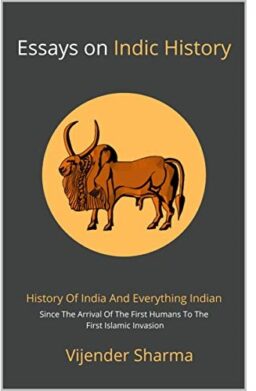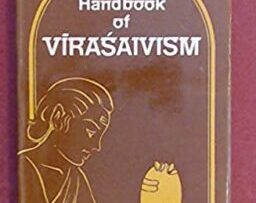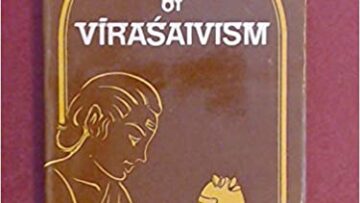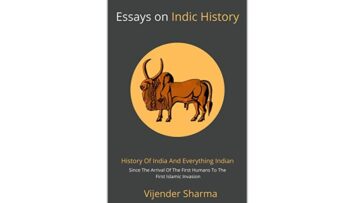Since the time I studied history as part of curriculum, I have been haunted by a question; How did Harappa city flourish in isolation without any rural support system or supply chain? Now, ie Three decades later, this book has given me the answer; Harappa was not an isolated city but part of Indus-Saraswati Civilisation spread across a million sq Kms having inter dependent urban, semi urban and rural settlements. If you also had such questions or if you felt in spite of studying history for years in school & college you do not have comprehensive picture, this book is for you.
The book, an anthology of 34 essays by the author, is an attempt to weave a coherent story with the help of latest archaeological & scientific discoveries, lesser-known facts; regarding antiquity of our civilisation, the scientific, technological, political, sociological progress it made, its contribution to philosophy, medicine, mathematics, astronomy and the connection between Indian philosophy and achievements in science, mathematics and arts. The chapters are arranged from the pre-historic ie Tale of Two Cities, which discusses the excavations of Mehrgarh and Bhirrana, till the time of Islamic invaders at the gate of India.
Commonly, history is merely a chronology of the various kings, kingdoms, dynasties & wars. We yearn to know India beyond the kings, dynasties and wars; What were the Indians doing when they were not fighting a war? What was the contribution of Indians to the society they lived in and the world around them? How foreign cultures viewed India and its diversity? This is where the book scores high! Another prickling point in any history book is its Delhi Centric or North India centric narrations, however, this book attempts to give equal space to all regions.
Without disclosing much, let me summarise the discussions in the book.
The technical achievements revealed by excavations of our earliest Neolithic sites; Mehrgarh, Bhirrana. The advances made by Indus-Saraswati civilisation in engineering and town planning, particularly the engineering marvels such as drainage system, great bath, roads, water harvesting of the city port of Dholavira, dockyard of Lothal and the extensive trade routes for international and domestic trade, etc. How little is known about the governance system existing in Saraswati civilisation? Was it a democracy or monarchy? Were they city states, or was it one big empire? Whether they had developed a writing system? Since, 2378 out of 3741 sites have been identified along the course of now dried up Saraswati River, will it be fair to call it Indus-Saraswati civilisation?
How did such an advanced civilsation end? Was there an Aryan invasion or an Aryan migration? From analysis of archeo-paleological, scientific, meteorological and other evidences, it appears that Sarswati valley civilisation ended mainly due to vagaries of monsoon and drying up of Saraswati River. The people moved eastwards for fertile lands & abundance of water. The book lists the Harappan practises still ingrained in our everyday life viz yogic posture, swastika, lost wax technique, rolling dices, bathing festivals, worship of Linga / Yoni Linga, fire rituals etc
South India in the meantime, leap-frogged into Iron age or Megalithic Age (skipping bronze age). Though there is literary evidence that suggests there was a flourishing civilisation with advanced urban planning, literature and overseas trade, due to lack of extensive excavation, very little is known about the societies. Book makes a case for wider excavations in peninsular India.
Dealing with the question of dating the oral traditions, the book establishes that RigVeda was composed earlier than 2000BCE. Then comes the period of 16 Mahajanpadas Continuum (a mix of Monarchy and Republican territories) from Bactria in the west to Bengal in the east. The Sabhas & Samitis that existed in Mahajanapadas are the ancestors of our Loksabha and Rajyasabha. The Mahajanapadas by 500BCE, had established extensive trade networks, within the subcontinent and with Southeast Asia (Suvarnabhoomi) and China as well. There were port towns in the west, east and peninsular India through which extensive international trade was happening. The Book has a lengthy discussion on Invasion by Greeks (Alexander), the famous Battle of Hydaspes (with king Porus) and impact the Greeks on Indian polity and how it lead to the rise of Mauryan Empire.
The chapters on trade & commerce enlightens on ancient monsoon-trade route, use of monsoon to navigate the sea, riverine trade, advances in ship building, the syncretic culture, Indianisation of the South-East Asia, the legend of Koundinya dynasty etc. Interesting to learn; how the people in southern and western India were building economic ties with places as far away as Rome and China, the adventure and enterprise of people from eastern & southern India, the seafarers of Kalinga and Muziris who took Indian produce and culture halfway across the world. Meantime, the silk roads & trade & transport hubs emerged in north and north west during post Mauryan reign of Kushans, Sakas and Pahlavas and had immense influence on the socio cultural- religious life, iconography etc. Simultaneously, South Of Vindhyas, the Satavahana empire emerged who along-with Sakas & controlled a large share of international trade from the Ports of Bharuch (Gujarat) to Machilipatnam (Andhra). During this period there was revival of Vedic rituals, Puranic Gods as evident from Rabatak inscription, Naneghat cave inscriptions (1st century BCE) and Reh Inscriptions. The existence of elliptical domes in Kushana Period is revealed in excavations in a palace complex at Kaushambi, this falsifies the theory that the dome is an Islamic influence in India.
The most beautiful chapters in the book are on, India’s gifts to the world in fields of performing arts, medicine, astronomy, Mathematics, Philosophy, language etc. The book succinctly discusses about Natya Shastra (Bharata Muni 500 BCE), Natasutras (600 BCE), Charaka Samhita (400 BCE), the Sushruta Samhita, Rig Vedic references to months, years, constellations etc Shatapatha Brahmana references to aspects of geometry, Brihat Samhita, of Varahmihira (500 BCE) which talks of zodiacs, nakshatras, several comets and their characteristics, Surya Siddhanta (400BCE to 400CE) which deals in planetary motions, their shapes, their orbits and time keeping (it was the first to identify time zones and also use sine, versine and cosine functions in calculating the movement of sun, moon and other planets), Aryabhatiya of the great Aryabhatta (500 CE) which deals in mathematical concepts like mensuration, time keeping, algebra (simple, simultaneous, quadratic and linear intermediate equations), units of time, the approximation of the value of Pi etc. The most significant find of all; the Bakhshali Manuscript, discovered in 1881, dated to 3rd century CE, contains the symbol for zero represented as a dot, this shows that zero was in use much before the manuscript was written. Both Surya Siddhanta and Aryabhatiya give the number of revolutions of Earth, in a yuga is 1,582,237,500 and that of moon is 57,753,336. This is actually the earliest mention of such large numbers. No other civilisation used or imagined such large numbers.
Arguably, the greatest gift of India to philosophy is the tradition of sceptical questioning; the Nasadiya Sukta in Rig Veda (10:129) which even doubts the ability of the Supreme Being, i.e. God, to know the truth! This eternal quest to know the truth led to the rise of Nyaya, Vaisheshika, Samkhya, Vedanta, Buddhist, Jain, Charvaka and other philosophies.
Panini’s Ashtadhyayi, the first work of its kind to lay down the rules of grammar for a language, is now widely believed to be the first artificial language & can be used to write a computer language.
The book seamlessly moves to the glorious accounts by foreign pilgrims, viz Faxian, Xuanzang about people & life in India and from there to the great empires of Kadambas, Pallavas and Chalukyas, in southern India and their invaluable contribution to Indian polity, religion, art, culture and philosophy. They patronised the Vedic, puranic religions as well as Jainism and Buddhism equally thus establishing syncretic culture. The book however seems to hurry through this part, for example, there is no discussion on the advances made in development of distinctive styles of temple architecture which lead to building of magnificent temples. The essay, Last empire of ancient India talks about the kingdom of the Harshvardhan of Pushyabhuti Dynasty who ruled a large part of northern, north-western and eastern India from Kanyakubja (Kannauj UP).
History is dynamic, with every excavation throwing up new archaeological evidences, many earlier beliefs are turning out to be false narratives and many theories earlier discarded as myths are turning out be historical facts. Newer technologies hitherto not used or relied upon by the traditional historians such has genetic studies, carbon dating, paleo archaeological studies, oceanography, astronomy, remote sensing etc have now unravelled many mysteries, found missing links and corroborated scriptural or literary evidences ( eg Sarasvati River). For this reason, history needs constant revising on the basis of latest findings. Hence, this book is important because it makes the readers (who may have read history decades earlier) aware of the latest findings and their implications on our knowledge of our past. Since, most of the facts discussed in the book are not found in text books, even though they were discovered 2-4 decades back, the reader becomes aware of the awful apathy and unwillingness of our academicians to include the latest archaeological finds in texts.
After reading, I couldn’t help the feeling that, it could have been better for the book to discuss in more detail on a following topics. The book though discusses the port cities and thriving international trade etc, it doesn’t discuss our ancient ship building capabilities. Where & how the ships were built in different epochs, do we find any archaeological evidences? What technology and materials were used?
Though we have been an agrarian society, not much is known about methods of cultivation. Was any rudimentary form of irrigation in vogue at least in the vicinity of the rivers or streams. What were the main crops grown & What was the food habits in different regions, whether our ancestors were predominantly eaters of meat or food grains? The book doesn’t delve on these important topics.
Similarly, though the book mentions the iron age, copper age etc, there is no discussion on how the smelting of ores was done? What type of furnaces were used? Have we found any remnants of same? Some historians say, movable furnaces were used to smelt ores, and the furnaces could be carried by the guilds as they moved. It would not just be interesting but also profitable to know how the high temperatures required for smelting were achieved in olden times.
Biggest miss of the compilation is the essay on the architecture. Great advances in architecture were made as evident from surviving ruins of Satavahana, Vakataka periods and the great temples of the Kadambas, Pallavas, Chalukyas etc. Three or more distinctive styles of temple architecture developed in Aihole School of Architecture in Karnataka. Strangely, there is no mention of the Vakataka period, which has given us the Great Ajanta caves, the Nandivardhana Fort (probably the oldest fort ruins in India), magnificent Pravareshwara Temple at Mansar etc.
Nonetheless, full marks to the author, the book with its easy readability succeeds in keeping the reader interested till the end. The book is timely, as there was a need for simple and effortlessly comprehensible books to take history to common readers. The incredible facts narrated in the book make us realise how less we know, or how less we remember of our history. To get the maximum from this book it is suggested to simultaneously google about anything you come across. The copious notes in the book regarding sources, references would also help the interested to read more.
Ancient Bharat extends from Balochistan in the west to Mynmar in the east, Turkmenistan in north to Indian ocean in south, it had 100s of epochs, 1000s of kingdoms, innumerable advances in science, maths, philosophy, art, architecture, etc; to present a consolidated picture of this in a compilation of few succinct essays is a super human effort and the author fairly succeeds in that. For the people who loved history during school but went on to different fields, this book is a beautiful gift to self.
Bharat Ratna Dr Bhimrao Ambedkar said, “A historian ought to be exact, sincere and impartial; free from passion, unbiased by interest, fear, resentment or affection; and faithful to the truth . . .” The author surely scores very high on these parameters.
Disclaimer: The opinions expressed in this article belong to the author. Indic Today is neither responsible nor liable for the accuracy, completeness, suitability, or validity of any information in the article.










